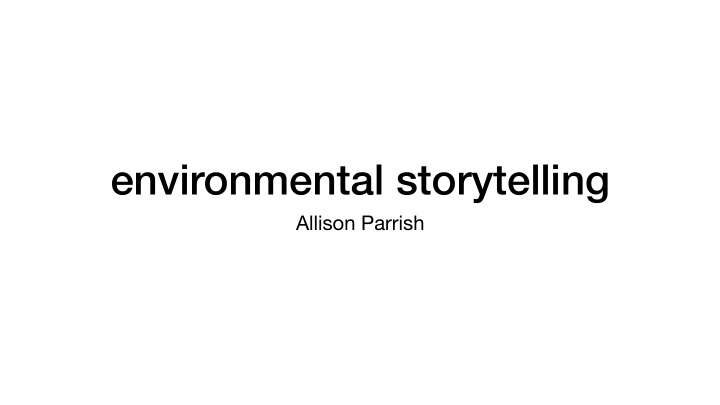



environmental storytelling Allison Parrish
“the story told by the game-world as if the player wasn't there” – Richard Rouse III at GDC 2010
• "the story can be told through objects" (Fernández-Vara 2011) • "no ideas but in things" (William Carlos Williams' imagist mantra) • How much story can you tell by defining the avatar and the environment? (Samyn 2008)
indexical storytelling (Fernández-Vara)
From Fernández-Vara (2011) • environments and objects in environments can be understood as what Charles Peirce calls "indices"—signs for which "the idea is physically connected with the sign" (e.g., a signpost shows where to go, smoke indicates fire, sneeze denotes a cold) • "An index has a relation to the event, often is the consequence of it, which points to something that happened or is going on, inviting the player to reconstruct what happened" • Detective stories are a good example: "The behavior restored in [detective work] games usually involves examining the environment, reading documents, cross-questioning witnesses and suspects, and eventually reconstructing past events." • Games with changeable state also provide indices. For example, being able to pick things up and put them down in Adventure: " In order to di ff erentiate one room from another, the player can drop an object in each location, leaving behind breadcrumbs of sorts. The objects become indications for the player herself to be able to solve the game, since the description of the game changes because it describes the object left behind" • Includes "ghosts" in games (records of other people's playthroughs, as in Mario Kart or Demon's Souls)
some evocative (non-digital) precedents (spaces and collections that can be "read")
A path is a prior interpretation of the best way to traverse a landscape, and to follow a route is to accept an interpretation, or to stalk your predecessors on it as scholars and trackers and pilgrims do. To walk the same way is to reiterate something deep; to move through the same space the same way is a means of becoming the same person, thinking the same thoughts. Rebecca Solnit (2001)
stations of the cross https://commons.wikimedia.org/wiki/File:Ji%C5%99et%C3%ADn_pod_Jedlovou,_calvary.jpg
Labyrinth of Versailles
dada/surrealist boxes Marcel Duchamp, Boîte-en-valise Joseph Cornell, Taglioni's Jewel Casket
Museum of Jurassic Technology https://www.youtube.com/watch?v=6BtrRMFrUoI a "museum about museums"
the "walking simulator"
"[W]alking simulators [are] games with an immersive use of exploration as a core mechanic utilised for environmental storytelling purposes" Carbo-Mascarell 2016
What Remains of Edith Finch Developed by Giant Sparrow https://youtu.be/q-fj8PhdWeI?t=430
some formal characteristics • movement through space (space is modeled in various ways, but frequently as a 3D environment with 1st person point of view) • certain areas are hidden or inaccessible until discovered or unlocked (keys, inventory items, puzzles) • some objects are interactive (and have their own rules for interactivity beyond the rules associated with moving through the space) • textual descriptions and voiceover • often give the appearance of being freely explorable environments, but in fact have a linear structure
glitches and alternative topologies
Gordon Matta-Clark, "Conical Intersect" Patrick LeMieux and Stephanie Boluk, "Triforce"
Pac-Man Kill Screen (Hodges 2007) Super Mario Bros. Minus World
Rouse's practical techniques • research ("authenticity and consistency allows players to buy into the world") • location backstory (what is the location used for? did something happen there? what elements will help communicate this?) • focus attention (shots, framing, reveals) • variable pacing (give players time to "soak up the world") • "embedded story elements" (signs, gra ffi ti, in-world audio, ambient life)
Works cited • Fernandez-Vara, Clara. “Game Spaces Speak Volumes: Indexical Storytelling.” DiGRA ’11 - Proceedings of the 2011 DiGRA International Conference: Think Design Play , DiGRA/Utrecht School of the Arts, 2011, http://www.digra.org/wp-content/ uploads/digital-library/Game-Spaces-Speak-Volumes.pdf. • Boluk, Stephanie, and Patrick LeMieux. Metagaming: Playing, Competing, Spectating, Cheating, Trading, Making, and Breaking Videogames. University of Minnesota Press, 2017. • Hodges, Don. “Pac Man’s Split Screen Level Analyzed and Fixed.” DonHodges.Com, 8 Dec. 2007, http://donhodges.com/ how_high_can_you_get2.htm. • Rosa, Carbo-Mascarell. “Walking Simulators: The Digitisation of an Aesthetic Practice.” DiGRA/FDG ’16 - Proceedings of the First International Joint Conference of DiGRA and FDG, Digital Games Research Association and Society for the Advancement of the Science of Digital Games, 2016. • Rouse III, R. “Environmental Narrative: Your World is Your Story.” Game Developers Conference, San Francisco, 2010. Slides and notes available at http://www.paranoidproductions.com/miscwritings/EnvironmentalNarrative.ppt • Samyn, Michaël. “The Graveyard Post Mortem.” Tale of Tales, 2 Nov. 2008, http://tale-of-tales.com/blog/the-graveyard-post- mortem/. • Solnit, Rebecca. Wanderlust: A History of Walking . Penguin, 2001.
Recommend
More recommend